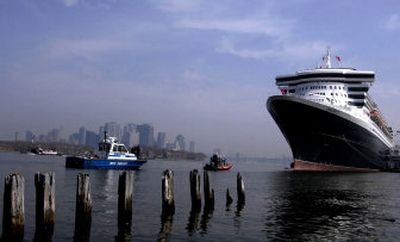Floating big ideas

John Heald, one of Carnival Cruise Lines’ most popular cruise directors, recently quipped to Avid Cruiser magazine about the industry’s inclination to ever bigger vessels: “Soon you won’t even need ports. You’ll walk to the back of the ship, and you’ll be on another continent – or in Jamaica.”
Lighthearted exaggeration? Maybe not.
Consider this: In the fall of 2009, you’ll be able to cruise on a ship the length of four football fields, and soaring some two-dozen decks high and 213 feet above the waterline.
The planned vessel, dubbed “Genesis” and recently announced by Royal Caribbean International, pre-emptively unseats the line’s not-yet-launched Freedom of the Seas – a 160,000-ton ship that, when it debuts this June, will nose out the current reigning colossus of the seas, the 150,000-ton Queen Mary 2.
“The race for largest liner has brought prestige, success, popularity and, quite often, profit,” says Bill Miller, maritime historian and author of more than 60 books on ocean liner history. “More people (have always) wanted to sail on the world’s largest and longest liners.”
Genesis likely will hold the “biggest ship at sea” title for a while, as the rest of the industry decides when – or if – to follow suit.
The vessel will, after all, be truly gargantuan. It will carry 6,400 passengers and dwarf anything else at sea designed for cruising. At an estimated 222,000 tons, its surfeit of real estate will have more knock-your-socks-off diversions than currently imaginable.
Royal Caribbean, of course, is the line that brought to sea such whiz-bang innovations as roller boarding, rock climbing, ice skating and even water surfing (on Freedom).
Costing about $230,000 per berth and requiring, according to the line, about 5,800 man-years to complete, Genesis will ka-ching in as the most expensive cruise ship ever built. Still, if history is any guide, some lines won’t take the mine-is-bigger-than-yours challenge lightly.
The ongoing tug o’ tonnage began even before the concept of modern cruising. According to historian Miller, “In 1897, the 14,900-ton, 655-foot-long Kaiser Wilhelm der Grosse … was the world’s largest vessel and the first to be called a ‘super liner.’ “
Similar superlatives subsequently were conferred on the 46,000-ton Titanic (1912). Cunard’s Queen Elizabeth (1940), at 83,600 tons, was the largest of all liners until 1996, Miller says.
By 1996, the “Fun Ship” line launched Carnival Destiny, the first cruise ship to exceed 100,000 tons. Two years later, the “Love Boat” line weighed in with the 109,000-ton Grand Princess.
In 1999, Royal Caribbean’s 139,280-ton Voyager of the Seas took the wind out of everyone else’s sails until 2004, when Cunard’s Queen Mary 2 debuted.
New heavyweights will continue to fill out the fleets, although none the size of Genesis … yet.
Industry observers expect either Carnival or Princess to order 200,000-ton cruise ships. In 2007, Carnival slates its 110,000-ton Freedom for February, while Princess’ 116,000-ton Emerald Princess is due that spring.
Italy-based MSC Cruises will debut two 135,000-ton vessels, Fantasia and Serenata, in 2008 and 2009, respectively. And Celebrity Cruises will take possession of its first “wide body” 117,000-ton vessel in the fall of 2008.
While not the heftiest new vessel planned, NCL’s Pride of Hawaii comes close. Most notably, when it debuts next month, the 93,500-ton ship will enter history as the largest U.S.-flagged passenger ship ever built. It will join the line’s Pride of America and Pride of Aloha offering seven-night cruises to Hawaii’s four main islands.
What is arguably the biggest seagoing behemoth, however, is still pie in the sky. A project called Freedom Ship (no relation to any other line’s Freedom venture) is envisioned as a true floating city – functioning more like an offshore destination in itself.
At nearly 1 mile long, 750 feet wide and 25 stories high, this maritime monster will incorporate 18,000 residential units and 10,000 hotel units accommodating more than 30,000 people. The vessel will circle the world every three years, spending 70 percent of its time docked offshore of major cities, and welcoming day-trippers on board to experience it.
On its Web site, the planners promise a school system, an international trade center and 100 acres of outdoor parkland. Residences of 300 square feet are estimated to carry $180,000 price tags, with premium 5,000-square-foot suites hovering as high as $44 million. At the moment, the project’s developers are still seeking investors.
Meanwhile, existing lines are pushing the amenities envelope ever further.
Royal Caribbean recently announced this knockout concept: a full-sized boxing ring on Freedom of the Seas. For die-hard Rocky wannabes, the line describes its “Fight Klub” as a place for “experienced boxers … to hone their skills or novices wanting to try something new …”
The announcement also says passengers “can test their chops with a variety of boxing-related activities, including one-on-one training sessions with an experienced instructor inside a full-size 20-foot by 20-foot Everlast boxing ring.” Speed bags, jump ropes, heavy bags and padded punching mitts also are available.
A couple of other features on Freedom of the Seas: an adults-only solarium with two cantilevered whirlpools that extend 12 feet beyond the sides of the ship, and a water park with interactive sculpture fountains and a cascading waterfall.
And Norwegian Cruise Line’s next ship – the 92,000-ton Pearl, arriving in 2007 – will give passengers the chance to hang out in cruisedom’s first-ever bowling alley – boasting four full-sized lanes.